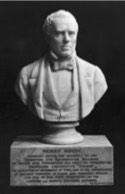Clement-Jones family - Person Sheet
Clement-Jones family - Person Sheet
Notes for Henry BOOTH
Helped George and Robeert Stephenson build the Rocket.
Henry Booth was a railway promoter and manager who played an important role in the planning of the world's first intercity railway. Booth's family were corn merchants and he began his working life in the same business. Then in 1822 a committee was formed to promote the Liverpool and Manchester Railway; Booth's father was a member. Henry acted as secretary on the committee and is believed to have written the original prospectus. He later became secretary and treasurer for the company when the Liverpool and Manchester Railway was incorporated in 1826. Booth worked closely with George Stephenson, the line's engineer, while the railway was under construction. In October 1829 the Rainhill Trials were held to find the best form of motive power for the line. Booth and Stephenson entered a locomotive for the trials, which was to be designed and built by the firm run by Stephenson's son Robert. Booth suggested to Robert the use of a multi-tubular boiler. The locomotive Rocket duly won and the company decided to use steam locomotives in preference to stationary engines. Booth wrote a history of the Liverpool and Manchester Railway which was published in 1830, several months before the line opened. This was the first history of a railway company to be written anywhere in the world. He later devised screw coupling and spring buffers for railway carriages. Booth continued in railway management for the rest of his professional life.
In an article published by the http://www.hslc.org.uk/ Henry Booth is described as :
"Doubtless the greatest genius, next to George Stephenson, was the indefatigable secretary and manager, Henry Booth, a Liverpool corn merchant, born in Rodney Street on 4th April 1788, to whom we are indebted for the introduction of the screw coupling between the coaches, which has since been extended to express goods and cattle trains. He was also the inventor of grease boxes for lubricating the axles of railway vehicles, and of the steam tubes fitted to the celebrated engine "Rocket", for which he was awarded half the £500 prize given by the directors for the successful locomotive at the Rainhill trial 8th October 1829."
Henry Booth was a railway promoter and manager who played an important role in the planning of the world's first intercity railway. Booth's family were corn merchants and he began his working life in the same business. Then in 1822 a committee was formed to promote the Liverpool and Manchester Railway; Booth's father was a member. Henry acted as secretary on the committee and is believed to have written the original prospectus. He later became secretary and treasurer for the company when the Liverpool and Manchester Railway was incorporated in 1826. Booth worked closely with George Stephenson, the line's engineer, while the railway was under construction. In October 1829 the Rainhill Trials were held to find the best form of motive power for the line. Booth and Stephenson entered a locomotive for the trials, which was to be designed and built by the firm run by Stephenson's son Robert. Booth suggested to Robert the use of a multi-tubular boiler. The locomotive Rocket duly won and the company decided to use steam locomotives in preference to stationary engines. Booth wrote a history of the Liverpool and Manchester Railway which was published in 1830, several months before the line opened. This was the first history of a railway company to be written anywhere in the world. He later devised screw coupling and spring buffers for railway carriages. Booth continued in railway management for the rest of his professional life.
In an article published by the http://www.hslc.org.uk/ Henry Booth is described as :
"Doubtless the greatest genius, next to George Stephenson, was the indefatigable secretary and manager, Henry Booth, a Liverpool corn merchant, born in Rodney Street on 4th April 1788, to whom we are indebted for the introduction of the screw coupling between the coaches, which has since been extended to express goods and cattle trains. He was also the inventor of grease boxes for lubricating the axles of railway vehicles, and of the steam tubes fitted to the celebrated engine "Rocket", for which he was awarded half the £500 prize given by the directors for the successful locomotive at the Rainhill trial 8th October 1829."


